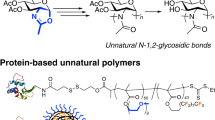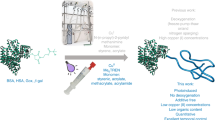Abstract

Gamete-gamete interactions are critically modulated by carbohydrate-protein interactions that rely on the carbohydrate-selective recognition of polyvalent carbohydrate structures1,2. A galactose-binding protein has been identified in mammalian spermatozoa3 that has similarity to the well-characterized hepatic asialoglycoprotein receptor4. With the aim of exploiting the ability of this class of proteins to bind and internalize macromolecules displaying galactose, we designed hybrid carbohydrate-antioxidant polymers to deliver antioxidant vitamin E (α-tocopherol) to porcine spermatozoa. Treatment of sperm cells with one hybrid polymer in particular produced large increases in intracellular sperm levels of α-tocopherol and greatly reduced endogenous fatty acid degradation under oxidative stress. The polymer-treated spermatozoa had enhanced physiological properties and longer half-lives, which resulted in enhanced fertilization rates. Our results indicate that hybrid polymer delivery systems can prolong the functional viability of mammalian spermatozoa and improve fertility rates, and that our functionally guided optimization strategy can be applied to the discovery of active glycoconjugate ligands.
This is a preview of subscription content, access via your institution
Access options
Subscribe to this journal
Receive 12 print issues and online access
$259.00 per year
only $21.58 per issue
Buy this article
- Purchase on Springer Link
- Instant access to full article PDF
Prices may be subject to local taxes which are calculated during checkout



Similar content being viewed by others
References
Millette, C.F. Distribution and mobility of lectin binding sites on mammalian spermatozoa. Clin. Exp. Immunoreprod. 4, 51–71 (1977).
Benoff, S. Carbohydrates and fertilization: an overview. Mol. Hum. Reprod. 3, 599–637 (1997).
Abdullah, M., Widgren, E.E. & O'Rand, M.G. A mammalian sperm lectin related to rat hepatocyte lectin. Mol. Cell. Biochem. 103, 155–161 (1991).
Ashwell, G. & Morell, A.G. The role of surface carbohydrates in the hepatic recognition and transport of circulating glycoproteins. Adv. Enzymol. 41, 99–128 (1974).
British Nutrition Foundation, ed. Unsaturated Fatty Acids. Nutritional and Physiological Siginificance. The Report of the British Nutrition Foundation's Task Force. (Chapman and Hall, London, 1992).
Cohn, W. et al. Tocopherol transport and absorption. Proc. Nutr. Soc. 51, 179–188 (1992).
Aitken, R.J. & Baker, M.A. Reactive oxygen species generation by human spermatazoa: a continuing enigma. Int. J. Androl. 25, 191–194 (2002).
Cerolini, S., Maldjian, A., Surai, P. & Noble, R.C. Viability, susceptibility to peroxidation and fatty acid composition of boar semen during liquid storage. Anim. Reprod. Sci. 58, 99–111 (2000).
Tulsiani, D.R. & Abou-Haila, A. Mammalian sperm molecules that are potentially important in interaction with female genital tract and egg vestments. Zygote 9, 51–69 (2001).
Topfer-Petersen, E. Carbohydrate-based interactions on the route of a spermatozoon to fertilization. Hum. Reprod. Update 5, 314–329 (1999).
Nixon, B. et al. Galactosyltransferase function during mammalian fertilization. Cells Tissues Organs 168, 46–57 (2001).
Davis, B.G. & Robinson, M.A. Drug delivery systems based on sugar-macromolecule conjugates. Curr. Opin. Drug Discov. Devel. 5, 279–288 (2002).
Duncan, R., Kopecek, J., Rejmanova, P. & Lloyd, J.B. Targeting of N-(2-hydroxypropyl)methacrylamide copolymers to liver by incorporation of galactose residues. Biochim. Biophys. Acta 755, 518–521 (1983).
Mammen, M., Chio, S.-K. & Whitesides, G.M. Polyvalent interactions in biological systems: implications for design and use of multivalent ligands and inhibitors. Angew. Chem. Int. Edn. Engl. 37, 2755–2794 (1998).
Ambrosi, M., Cameron, N.R. & Davis, B.G. Lectins: tools for the molecular understanding of the glycocode. Org. Biomol. Chem. 3, 1593–1608 (2005).
Gabius, H.-J., Siebert, H.-C., Andre, S., Jimenez-Barbero, J. & Ruediger, H. Chemical biology of the sugar code. ChemBioChem 5, 740–764 (2004).
Lee, Y.C. et al. Binding of synthetic oligosaccharides to the hepatic Gal GalNac lectin - dependence on fine-structural features. J. Biol. Chem. 258, 199–202 (1983).
Choi, S.-K., Mammen, M. & Whitesides, G.M. Generation and in situ evaluation of libraries of poly(acrylic acid) presenting sialosides as side chains as polyvalent inhibitors of influenza-mediated hemagglutination. J. Am. Chem. Soc. 119, 4103–4111 (1997).
Arranz-Plaza, E., Tracy, A.S., Siriwardena, A., Pierce, J.M. & Boons, G-J. High-avidity, low-affinity multivalent interactions and the block to polyspermy in Xenopus laevis. J. Am. Chem. Soc. 124, 13035–13046 (2002).
Ladmiral, V., Melia, E. & Haddleton, D.M. Synthetic glycopolymers: an overview. Eur. Polym. J. 40, 431–449 (2004).
Rihova, B. Receptor-mediated targeted drug or toxin delivery. Adv. Drug Deliv. Rev. 29, 273–289 (1998).
Ringsdorf, H. Structure and properties of pharmacologically active polymers. J. Polym. Sci. Polym. Symp. 51, 135–153 (1975).
Ambrosi, M. et al. Influence of preparation procedure on polymer composition: synthesis and characterisation of polymethacrylates bearing β-D-glucopyranoside and β-D-galactopyranoside residues. J. Chem. Soc. Perkin Trans. I, 45–52 (2002).
Hoyes, K., Nettleton, J., Lawson, R. & Morris, I. Transferrin-dependent uptake and dosimetry of Auger-emitting diagnostic radionuclides in human spermatozoa. J. Nucl. Med. 39, 895–899 (1998).
Morales, C.R. Role of sialic acid in the endocytosis of prosaposin by the conciliated cells of the rat efferent ducts. Mol. Reprod. Dev. 51, 156–166 (1998).
Ohkawa, H., Nobuko, O. & Yagi, K. Assay for lipid peroxides in animal tissues by thiobarbituric acid reaction. Anal. Biochem. 95, 351–358 (1979).
Evenson, D., Larson, K. & Jost, L. Sperm chromatin structure assay: its clinical use for detecting sperm DNA fragmentation in male infertility and comparisons with other techniques. J. Androl. 23, 25–43 (2002).
Fraga, C.G., Motchnik, P.A., Wyrobek, A.J., Rempel, D.M. & Ames, B.N. Smoking and low antioxidant levels increase oxidative damage to sperm DNA. Mutat. Res. 351, 199–203 (1996).
Perez-Pe, R. et al. Prediction of fertility by centrifugal countercurrent distribution (CCCD) analysis: correlation between viability and heterogeneity of ram semen and field fertility. Reproduction 123, 869–875 (2002).
Ambrosi, M., Cameron, N.R., Davis, B.G. & Stolnik, S. Investigation of the interaction between peanut agglutinin and synthetic glycopolymeric multivalent ligands. Org. Biomol. Chem. 3, 1476–1480 (2005).
Acknowledgements
We would like to thank JSR Healthbred and the UK Department of Trade and Industry (DTI) for funding (DTI Smart Award), R. Hunter (Unilever) for advice and technical assistance with GPC determinations, K. Harrison for video assistance, and M. Alvarez-Reyes for assistance with confocal microscopy.
Author information
Authors and Affiliations
Corresponding authors
Ethics declarations
Competing interests
A.M., P.P. and R.C.N. are/have been employees of JSR Healthbred who may have longer-term goals in exploiting this technology. An initial patent application has now lapsed.
Supplementary information
Supplementary Table 1
Composition of terpolymers. (PDF 59 kb)
Supplementary Video 1
Treated sperm at Day 3. (MOV 8496 kb)
Supplementary Video 2
Untreated sperm at Day 3. (MOV 7421 kb)
Supplementary Scheme 1
Monomer synthesis. (PDF 82 kb)
Supplementary Scheme 2
Polymer synthesis. (PDF 94 kb)
Rights and permissions
About this article
Cite this article
Fleming, C., Maldjian, A., Da Costa, D. et al. A carbohydrate-antioxidant hybrid polymer reduces oxidative damage in spermatozoa and enhances fertility. Nat Chem Biol 1, 270–274 (2005). https://doi.org/10.1038/nchembio730
Received:
Accepted:
Published:
Issue Date:
DOI: https://doi.org/10.1038/nchembio730
This article is cited by
-
The glyco-regioisomerism effect on dynamic interactions between glycopolymers with galactose pendants and benzoxaborole-containing polymer
Science China Chemistry (2018)
-
Giant Polymersome Protocells Dock with Virus Particle Mimics via Multivalent Glycan-Lectin Interactions
Scientific Reports (2016)
-
RAFT-based tri-component fluorescent glycopolymers: synthesis, characterization and application in lectin-mediated bacterial binding study
Glycoconjugate Journal (2014)
-
Rheological behavior of aminosaccharide-based glycopolymers obtained from ethylene-vinyl alcohol copolymers
Polymer Journal (2011)
-
Targeted antioxidant delivery prolongs sperm lifespan
Nature Chemical Biology (2005)



